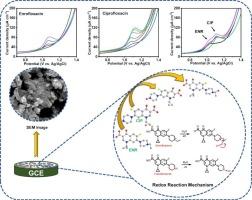Development of a low-cost zirconium molybdate bimetallic center electrochemical sensor for simultaneous enrofloxacin and ciprofloxacin detection in food samples
IF 4.9
2区 化学
Q1 CHEMISTRY, ANALYTICAL
引用次数: 0
Abstract
A bimetallic zirconium molybdate (ZMO) nanostructure was prepared by a simple hydrothermal method. It was characterized as a selective, non-enzymatic electrochemical sensing platform for the simultaneous detection of enrofloxacin (ENR) and ciprofloxacin (CIP) for the first time. Comprehensive structural and morphological characterizations confirm the formation of nanoflakes with a rough, interconnected architecture and uniform elemental distribution, providing abundant active sites for electrochemical reactions. The enhanced sensing performance was attributed to the synergistic redox activity of Zr and Mo species, which facilitated rapid electron transfer and strong analyte interaction. The sensor demonstrated excellent sensitivity with detection limits of 0.014 μM for ENR and 0.019 μM for CIP, along with remarkable selectivity in the presence of interfering species. Furthermore, the sensor demonstrated excellent reproducibility, stability in repeated measurements, and recovery from spiked real food samples, indicating its potential for practical use. The resulting sensor offers an effective and cost-effective approach for in situ monitoring of fluoroquinolone antibiotics, supporting food safety assurance initiatives and combating the growing threat of antimicrobial resistance.

同时检测食品中恩诺沙星和环丙沙星的低成本钼酸锆双金属中心电化学传感器的研制
采用简单的水热法制备了双金属钼酸锆(ZMO)纳米结构。首次建立了同时检测恩诺沙星(ENR)和环丙沙星(CIP)的选择性、非酶电化学传感平台。全面的结构和形态表征证实了纳米片的形成具有粗糙、相互连接的结构和均匀的元素分布,为电化学反应提供了丰富的活性位点。Zr和Mo的协同氧化还原活性促进了快速的电子转移和强的分析物相互作用,从而增强了传感性能。该传感器对ENR的检测限为0.014 μM,对CIP的检测限为0.019 μM,对干扰物有很好的选择性。此外,该传感器在重复测量中表现出出色的再现性、稳定性和从添加的真实食品样品中恢复的能力,表明其具有实际应用的潜力。由此产生的传感器为氟喹诺酮类抗生素的现场监测提供了一种有效和具有成本效益的方法,支持食品安全保障举措并应对日益严重的抗菌素耐药性威胁。
本文章由计算机程序翻译,如有差异,请以英文原文为准。
求助全文
约1分钟内获得全文
求助全文
来源期刊

Microchemical Journal
化学-分析化学
CiteScore
8.70
自引率
8.30%
发文量
1131
审稿时长
1.9 months
期刊介绍:
The Microchemical Journal is a peer reviewed journal devoted to all aspects and phases of analytical chemistry and chemical analysis. The Microchemical Journal publishes articles which are at the forefront of modern analytical chemistry and cover innovations in the techniques to the finest possible limits. This includes fundamental aspects, instrumentation, new developments, innovative and novel methods and applications including environmental and clinical field.
Traditional classical analytical methods such as spectrophotometry and titrimetry as well as established instrumentation methods such as flame and graphite furnace atomic absorption spectrometry, gas chromatography, and modified glassy or carbon electrode electrochemical methods will be considered, provided they show significant improvements and novelty compared to the established methods.
 求助内容:
求助内容: 应助结果提醒方式:
应助结果提醒方式:


